
So sánh mô hình môi giới A-Book so với B-Book so với mô hình môi giới lai
Mục lục
A-Book, B-Book và các mô hình hybrid là các phương pháp thực hiện giao dịch được các nhà môi giới sử dụng để quản lý đơn hàng của khách hàng và rủi ro. Những mô hình này đại diện cho các cách khác nhau mà các nhà môi giới sẽ thực hiện giao dịch cho khách hàng của họ, và cung cấp câu chuyện cho các công ty giao dịch sử dụng để phòng ngừa hoặc không phòng ngừa rủi ro liên quan đến các đơn hàng của khách hàng. Các mô hình thực hiện hình thành mối quan hệ của nhà môi giới với thị trường cũng như cách họ tạo ra doanh thu, cách họ quản lý các xung đột lợi ích của mình, và cách họ gián tiếp ảnh hưởng đến kết quả của các nhà giao dịch và tỷ suất lợi nhuận của nhà môi giới.
Có một sự lựa chọn rộng lớn các nhà giao dịch trong thị trường tài chính và ngành công nghiệp giao dịch. Các công ty môi giới giống như động cơ kết nối với thị trường. Trong số những phương thức thực hiện mà được hiểu rõ, bao gồm các mô hình thực hiện A-Book và B-Book phổ biến nhất, cũng như các công ty môi giới Hybrid, mỗi loại đều cung cấp một mô hình hoạt động khác nhau với logic, rủi ro và đạo đức khác nhau.
Đối với bất kỳ ai có kế hoạch trong tương lai để mở một công ty môi giới hoặc cho các nhà giao dịch đang đánh giá cách mà môi giới của họ hoạt động, điều cần thiết là phải hiểu về ba mô hình này. Việc lựa chọn một mô hình sẽ xác định tính minh bạch, quan hệ giữa môi giới và khách hàng, sự tuân thủ và triển vọng thành công lâu dài trong môi trường giao dịch ngày càng trở nên cạnh tranh trong không gian kỹ thuật số.
Những điểm chính
A-Book, B-Book và mô hình Hybrid là ba cách khác nhau mà các nhà môi giới có thể thực hiện giao dịch và chuyển giao rủi ro thông qua khách hàng.
- Các nhà môi giới A-Book, như tên gọi đã gợi ý, chuyển giao việc thực hiện các giao dịch cho các nhà cung cấp thanh khoản, tạo ra sự minh bạch rõ ràng và làm cho lợi ích của các nhà môi giới phù hợp với lợi ích của nhà giao dịch.
- Các nhà môi giới B-Book "nội bộ hóa" giao dịch, vị trí của khách hàng trong nhà, kiếm tiền thông qua chênh lệch giá và quản lý rủi ro trong khi thực hiện các hoạt động được quy định yêu cầu kiểm soát nội bộ vững chắc để thúc đẩy sự công bằng và niềm tin của khách hàng.
- Các nhà môi giới lai sử dụng cả hai mô hình để tạo ra mức độ kiểm soát cao hơn thông qua việc phân tích hồ sơ khách hàng và định tuyến thông minh - các nhà môi giới cần phải cân bằng giữa tính minh bạch, kiểm soát rủi ro và lợi nhuận.
- Một điều cần lưu ý là đổi mới công nghệ kết hợp với quy định đang phát triển vào năm 2025 sẽ thúc đẩy các nhà môi giới trở nên tự động hóa hơn, có thể kiểm toán và có sự biến đổi trong việc thực hiện của khách hàng.
- Đạo đức, tính minh bạch và sự tuân thủ ngày càng trở nên quan trọng hơn khi các nhà môi giới bắt đầu xây dựng niềm tin với khách hàng và tiến tới sự bền vững và tăng trưởng liên tục.
A-Book so với B-Book so với Hybrid: Những khác biệt chính
Quyết định mô hình môi giới nào là đúng cho bạn, hoặc hiểu cách thức hoạt động của nhà môi giới của bạn, bắt đầu với việc hiểu những khác biệt cơ bản trong các loại thực hiện. Bảng dưới đây tóm tắt cấu trúc, mục đích và sự khác biệt về tính phù hợp giữa các mô hình A-Book, B-Book và Hybrid.
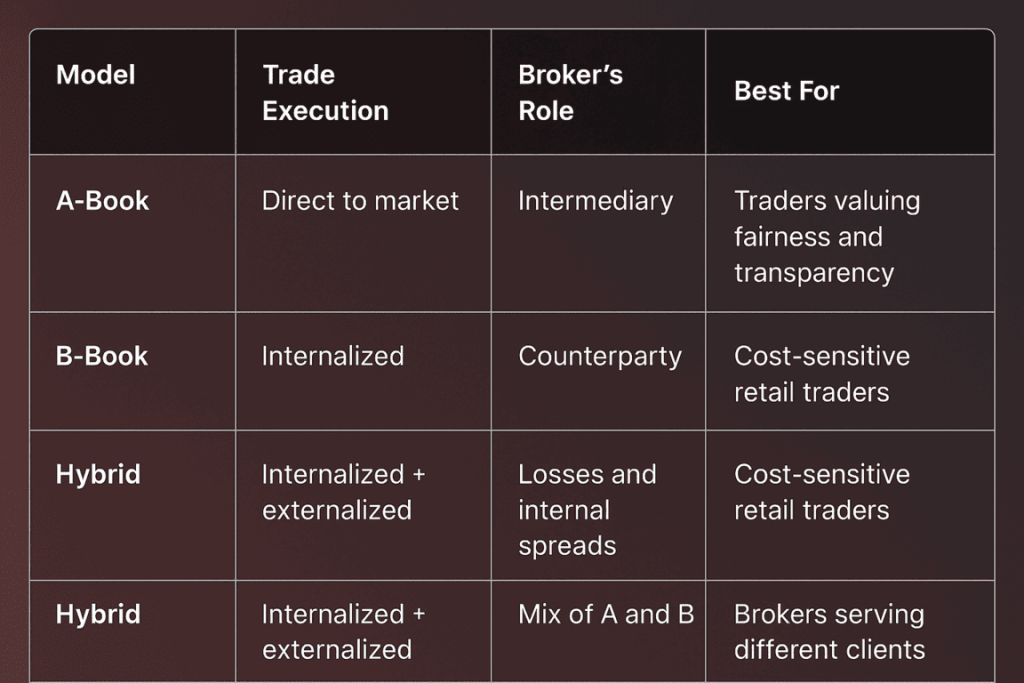
Mỗi mô hình đều có những đánh đổi về tính minh bạch, rủi ro và lợi nhuận. Việc hiểu những khác biệt này là rất quan trọng để chọn đúng đối tác hoặc thiết kế cấu trúc môi giới phù hợp, điều mà chúng tôi sẽ đề cập trong khối tiếp theo.
Các Mô Hình Môi Giới Khác Nhau
Để điều hướng trong lĩnh vực tài chính, việc hiểu rõ cách thức hoạt động của các công ty môi giới và những gì tạo nên sự khác biệt giữa các mô hình là điều cần thiết. Đóng vai trò là cầu nối giữa các nhà môi giới và các nhà giao dịch, một công ty môi giới phục vụ như nền tảng của quy trình giao dịch. Công ty môi giới chịu trách nhiệm đảm bảo trải nghiệm giao dịch và sự hài lòng của khách hàng. Cách mà một nhà môi giới thực hiện các giao dịch, quản lý rủi ro, duy trì tính minh bạch và đảm bảo sự công bằng phụ thuộc vào mô hình môi giới đã chọn.
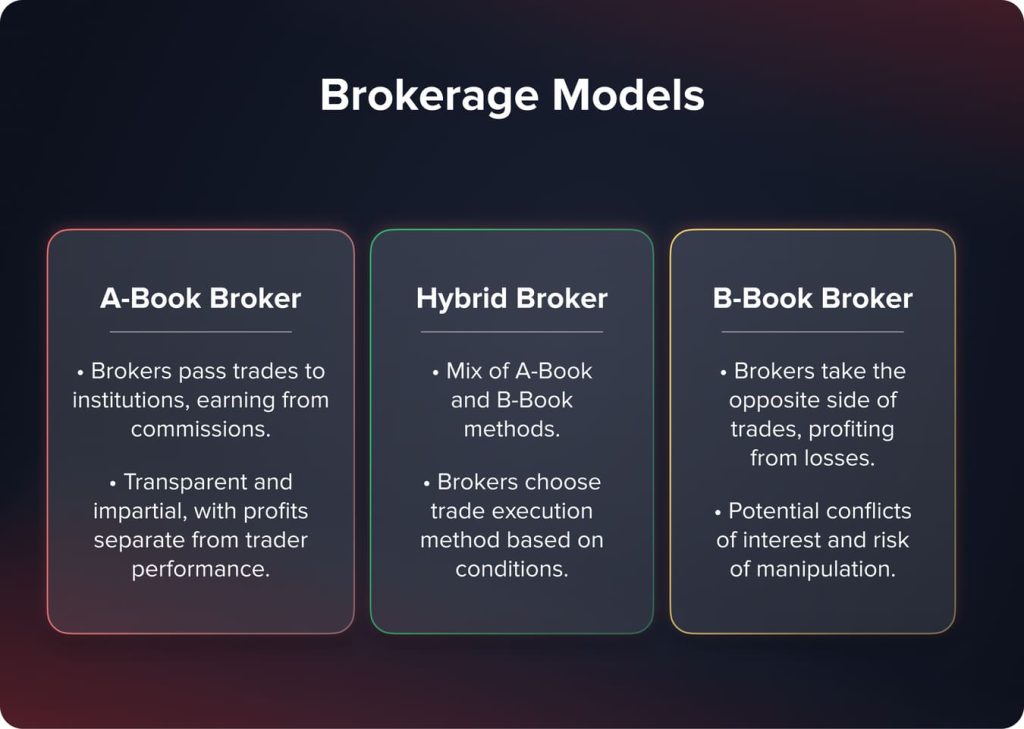
Vì vậy, điều quan trọng là phải tìm hiểu từng mô hình, xem xét các hoạt động bên trong, ưu điểm và nhược điểm.
Mô Hình Môi Giới A-Book
Hãy bắt đầu bằng cách xem xét mô hình A Book, nơi vai trò của nhà môi giới rất đơn giản; họ chỉ đơn giản là truyền đạt đơn đặt hàng của các nhà giao dịch đến các tổ chức tài chính, như ngân hàng, với vai trò trung gian. Trong thiết lập này, nhà môi giới không đối kháng với vị trí của các nhà giao dịch. Cách tiếp cận này cũng được gọi là Xử lý liên tục (STP). Thu nhập của các nhà môi giới chỉ đến từ hoa hồng và chênh lệch giá thay vì từ các hoạt động giao dịch, thúc đẩy tính minh bạch. Vì lợi nhuận của các nhà môi giới không phụ thuộc vào hiệu suất của các nhà giao dịch, họ có thể duy trì lập trường khách quan trong việc tạo điều kiện cho các giao dịch.
Bạn cũng có thể thích

Mô Hình Môi Giới B-Book
Mặt khác, mô hình môi giới B hoạt động trái ngược với mô hình A. Ở đây, môi giới thực hiện các vị trí đối lập với các nhà giao dịch. Chẳng hạn, nếu một nhà giao dịch mua vào một vị thế thị trường, thì môi giới sẽ thực hiện một vị thế và ngược lại.
Nếu nhà giao dịch hoạt động tốt, công ty môi giới sẽ bị thua lỗ. Nếu nhà giao dịch gặp phải thua lỗ, thì công ty môi giới sẽ có lợi nhuận. Tình huống này có thể dẫn đến xung đột lợi ích, vì công ty môi giới thu lợi từ việc các nhà giao dịch thua lỗ giao dịch của họ. Trong khi quản lý tất cả các rủi ro nội bộ bằng cách không gửi giao dịch đến một tổ chức khác có những ưu điểm của nó, nó cũng có thể khuyến khích các hành vi như săn stop loss và thao túng giá cả, điều này ảnh hưởng tiêu cực đến các nhà giao dịch. Những thực tiễn như vậy có thể khiến cho mô hình này khó thu hút được cơ sở khách hàng và làm nổi bật tầm quan trọng của việc duy trì mức độ minh bạch.
Mô Hình Môi Giới Lai
Mô hình Hybrid kết hợp các yếu tố của cả mô hình sách A và sách B. Trong kịch bản này, nhà môi giới có sự linh hoạt để quyết định liệu có thực hiện các lệnh thông qua một tổ chức hay xử lý chúng nội bộ. Quyết định này phụ thuộc vào các yếu tố như điều kiện thị trường, hồ sơ nhà giao dịch và các chiến lược quản lý rủi ro được thực hiện bởi nhà môi giới.
Mô hình Hybrid nhằm kết hợp tính minh bạch của mô hình A book, với quản lý rủi ro của mô hình B book.
Huyền thoại và Thực tế về A/B-Book
Có nhiều hiểu lầm về các mô hình môi giới, đặc biệt là với những trader mới, và sự thật về mô hình A-Book, B-Book và Hybrid có thể giúp bạn đưa ra những lựa chọn thông thái và phát triển niềm tin với nhà môi giới của bạn.
Huyền thoại 1: Các nhà môi giới A-Book không tạo ra lợi nhuận
Thực tế: Mặc dù các nhà môi giới A-Book không thu lợi từ các khoản thua lỗ, họ kiếm lợi từ các khoản chênh lệch, hoa hồng và các khoản hoàn lại khối lượng từ các nhà cung cấp thanh khoản. Vì vậy, trọng tâm của A-Book là kiếm lợi nhuận thông qua khối lượng giao dịch, các khoản chênh lệch và hoa hồng.
Huyền thoại 2: B-Book bị hiểu nhầm
Thực tế: Đôi khi có một sự hiểu lầm về việc B-Books chứa các yếu tố không đạo đức. Tuy nhiên, thực tế không phải như vậy, và có rất nhiều nhà môi giới được quản lý tốt sử dụng B-Books và hoạt động với các tiêu chuẩn công bằng, minh bạch và quản lý rủi ro. Các vấn đề chỉ có thể phát sinh khi các nhà môi giới tham gia vào các thực hành không đạo đức thực sự như săn lệnh dừng hoặc thao túng giá cả, điều này bị các cơ quan quản lý uy tín nghiêm cấm.
Huyền thoại 3: Các mô hình lai chỉ đơn giản là B-Books công khai
Thực tế: Chắc chắn rằng, một số nhà môi giới lai được cấu trúc kém có thể lợi dụng mô hình lai. Tuy nhiên, một nhà môi giới lai được cấu trúc đúng cách có thể truyền đạt rõ ràng đến khách hàng rằng họ đang kết hợp hiệu quả logic A-Book và B-Book trong khi cố gắng đạt được sự cân bằng hoặc thăng bằng trong rủi ro và lợi nhuận. Hầu hết các nhà môi giới tiên tiến đang thực hiện việc phân tích và lập hồ sơ khách hàng của họ, phòng ngừa một cách linh hoạt bằng nhiều cách khác nhau, và thực hiện giao dịch bằng cách sử dụng các công nghệ khác nhau theo thời gian thực, tất cả mà không hy sinh sự rõ ràng, công bằng hoặc minh bạch.
Lịch Sử Ngắn Gọn về Các Mô Hình Môi Giới
Trong hai mươi năm qua, ngành môi giới đã trải qua những thay đổi to lớn do sự phát triển công nghệ, quy định và nhu cầu đặc thù của chính các nhà giao dịch. Việc hiểu cách thức mà ngành môi giới đã thay đổi qua các năm là rất cần thiết để hiểu được trạng thái hiện tại của mô hình môi giới ngày nay.
Đầu những năm 2000: Sự thống trị của nhà môi giới Dealing Desk
Vào đầu những năm 2000, hầu hết giao dịch bán lẻ diễn ra thông qua các môi giới bàn giao dịch trực tiếp (nhà tạo lập thị trường). Các môi giới bàn giao dịch sẽ thực hiện các giao dịch của khách hàng nội bộ, cho phép họ quản lý giá cả và rủi ro trong khi tạo ra lợi nhuận. Thật không may, điều này cũng tạo ra xung đột lợi ích, dẫn đến thiếu minh bạch và cuối cùng là sự không hài lòng của các nhà giao dịch. Lời kêu gọi về các phương thức thực hiện bền vững hơn bắt đầu gia tăng.
Từ giữa những năm 2000 đến những năm 2010: Triển khai STP, ECN, & A-Book
Những tiến bộ trong công nghệ và việc hiện đại hóa quy định đã dẫn đến sự chấp nhận của Quy trình Thông suốt (STP) và Mạng lưới Giao tiếp Điện tử (ECN). Điều này đã mở đường cho mô hình A-Book, cho phép các nhà môi giới chuyển giao đơn hàng của khách hàng đến một nhà cung cấp thanh khoản, giảm thiểu xung đột lợi ích vốn có, đồng thời tạo điều kiện cho thanh khoản và sự đa dạng tổng hợp trước đây không thể đạt được nhờ vào sự minh bạch được cải thiện.
Mô hình môi giới lai thập niên 2020
Đến khi chúng tôi đạt đến thập kỷ 2020, các nhà môi giới ngày càng yêu cầu những trung gian có khả năng linh hoạt trong việc điều chỉnh phù hợp với các loại khách hàng khác nhau mà họ xử lý, cùng với rủi ro kinh doanh vốn có thường phát sinh khi tính đến từng sự khác biệt của khách hàng. Mặc dù các mô hình lai đã tồn tại trước đó, nhưng các mô hình môi giới lai đã tạo ra một liên tục mà trong đó các chiến lược A-book và B-book có thể tồn tại, tùy thuộc vào hồ sơ của một nhà giao dịch và loại khách hàng, trái ngược với bối cảnh thị trường hoặc hồ sơ rủi ro.
Một yếu tố chính trong việc phát triển các mô hình môi giới hybrid có tác động tích cực đáng kể là việc sử dụng phân tích và các hệ thống dựa trên trí tuệ nhân tạo (AI) giúp nâng cao khả năng tăng cường tính minh bạch để phù hợp với các tiêu chí quản lý rủi ro vào thời điểm mà chi phí được phép trở lại mức bình thường hơn do điều kiện cạnh tranh.
Tiến hóa của các mô hình môi giới
Sự phát triển của các mô hình môi giới phản ánh nhu cầu thay đổi của các nhà giao dịch và nỗ lực liên tục trong việc cải thiện quản lý rủi ro và lợi nhuận cho các nhà môi giới. Ban đầu, các nhà môi giới chủ yếu dựa vào các mô hình B Book, sử dụng vị thế của họ để kiểm soát rủi ro và đảm bảo lợi nhuận nội bộ. Tuy nhiên, phương pháp này thường tạo ra điều kiện không thuận lợi cho các nhà giao dịch, dẫn đến việc chuyển sang các môi trường giao dịch minh bạch và công bằng.
Để phản ứng với sự thay đổi này, mô hình A Book đã xuất hiện, thúc đẩy tính minh bạch bằng cách liên kết các nhà giao dịch với thị trường và giảm thiểu xung đột lợi ích. Mặc dù có lợi cho các nhà giao dịch, nhưng phương pháp này đã đặt ra những thách thức về doanh thu cho các nhà môi giới, do đó đã dẫn đến sự ra đời của mô hình Hybrid. Mô hình Hybrid cung cấp một cách tiếp cận cho phép các nhà môi giới tối ưu hóa quản lý rủi ro và tạo ra doanh thu trong khi vẫn duy trì tính công bằng và minh bạch.
Mỗi mô hình đều cung cấp một tập hợp các lợi ích, nhược điểm và quy trình hoạt động bị ảnh hưởng bởi sự thay đổi trong ngành giao dịch.
Khi chúng ta khám phá sâu hơn vào từng mô hình trong các phần tiếp theo, các nhà giao dịch và môi giới sẽ có được những hiểu biết để giúp họ chọn mô hình phù hợp nhất với chiến lược giao dịch, những cân nhắc về đạo đức và mục tiêu tài chính của họ.
Mô Hình Giao Dịch A-Book
Mô hình A Book đóng vai trò như một cầu nối kết nối các nhà giao dịch với thị trường. Trong mô hình này, các nhà môi giới chuyển tiếp các đơn đặt hàng của nhà giao dịch trực tiếp đến các nhà cung cấp thanh khoản, bao gồm các ngân hàng, các nhà môi giới tổ chức lớn và các thực thể tài chính khác. Thay vì thực hiện các vị thế đối lập với các giao dịch của khách hàng, các nhà môi giới trong khuôn khổ này chủ yếu đóng vai trò là trung gian.
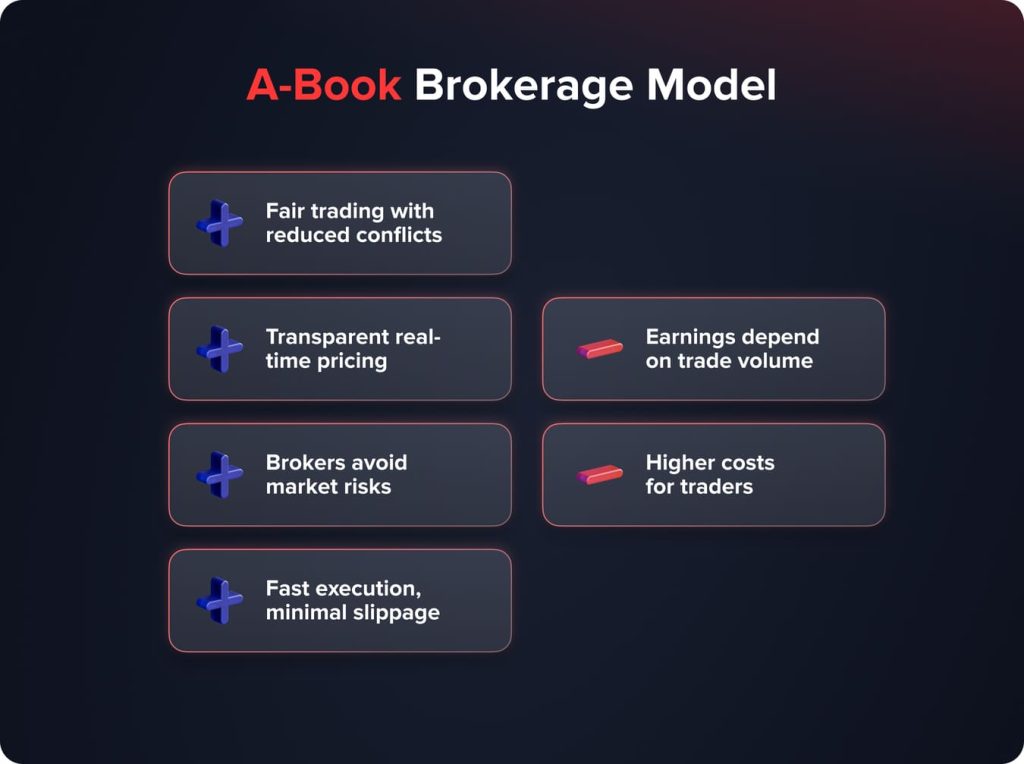
Trong mô hình A Book, các tổ chức tài chính lớn đóng vai trò bằng cách cung cấp các tùy chọn thị trường và đảm bảo hoàn thành đơn hàng hiệu quả. Họ cho phép giá thị trường theo thời gian thực và thực hiện giao dịch, thúc đẩy sự minh bạch và độ tin cậy trong môi trường giao dịch.
Lợi ích của Mô hình Môi giới A-Book
Một trong những lợi ích của mô hình môi giới A Book là thiết lập một môi trường giao dịch công bằng. Bằng cách truyền tải các giao dịch đến các nhà cung cấp thanh khoản hoặc các thị trường liên ngân hàng mà không đối kháng với các vị thế của nhà giao dịch, hệ thống này giảm thiểu xung đột lợi ích. Điều này được coi là một cách tiếp cận công bằng hơn.
Các nhà giao dịch có cơ hội truy cập dữ liệu thị trường và xem giá mua và bán, điều này rất cần thiết cho những người phụ thuộc nhiều vào phân tích thị trường cho các chiến lược giao dịch của họ. Sự minh bạch này tạo ra một cảm giác tin tưởng giữa nhà môi giới và nhà giao dịch, điều này là rất quan trọng cho sự thành công lâu dài trong ngành giao dịch.
Một lợi ích quan trọng khác của mô hình A Book là khả năng bảo vệ các nhà môi giới khỏi rủi ro thị trường. Ngược lại với mô hình B Book, nơi mà các nhà môi giới phải đối mặt với lợi nhuận hoặc thua lỗ từ các vị thế của trader, mô hình A Book giảm thiểu rủi ro này bằng cách chỉ định các đơn hàng cho các nhà cung cấp thanh khoản. Điều này đảm bảo rằng thu nhập của các nhà môi giới không bị ảnh hưởng bởi sự biến động của thị trường hoặc thắng thua của các trader. Một chiến lược thận trọng như vậy chứng tỏ có giá trị trong thời gian thị trường biến động mạnh, bảo vệ sự ổn định của các nhà môi giới.
Bạn cũng có thể thích

Thêm vào đó, mô hình A Book cho phép tiếp cận thị trường đa dạng trong khi cung cấp tốc độ thực hiện để giảm thiểu trượt giá. Sự nhanh chóng và hiệu quả này rất quan trọng đối với các nhà giao dịch sử dụng các chiến lược như scalping, nơi lợi nhuận thường đến từ việc khai thác các biến động giá trong một khoảng thời gian ngắn.
Nhược điểm của Mô hình Giao dịch A-Book
Tuy nhiên, mặc dù có những lợi thế, mô hình A Book vẫn gặp phải một số khó khăn.
Dựa hoàn toàn vào doanh thu từ hoa hồng và chênh lệch có thể đặt ra thách thức cho các nhà môi giới vì thu nhập của họ liên quan chặt chẽ hơn đến khối lượng giao dịch hơn là lợi nhuận hoặc thua lỗ từ các giao dịch. Trong thời gian hoạt động giao dịch hoặc thị trường ngừng hoạt động, các nhà môi giới có thể phải đối mặt với sự giảm sút trong dòng doanh thu, ảnh hưởng đến khả năng sinh lời của họ. Hạn chế này nhấn mạnh tầm quan trọng của việc xây dựng một cơ sở khách hàng và thực hiện các chiến thuật giữ chân khách hàng.
Đối với các nhà giao dịch hoạt động theo mô hình A Book, chi phí hoa hồng và chênh lệch có thể tương đối cao, dẫn đến chi phí giao dịch tăng lên. Cấu trúc này có thể không khả thi về mặt tài chính cho các nhà giao dịch có tài khoản nhỏ hơn hoặc những người thích giao dịch với số lượng lớn. Điều quan trọng đối với những nhà giao dịch như vậy là phải đánh giá cẩn thận các tác động về chi phí để đảm bảo rằng chi phí giao dịch không vượt quá lợi nhuận.
Mô Hình Môi Giới B-Book
Mô hình B-Book đại diện cho một chiến lược vận hành khác biệt, nơi các nhà môi giới thực sự đóng vai trò là bên đối tác cho các vị thế của nhà giao dịch. Trong mô hình này, thay vì chuyển hướng các đơn đặt hàng đến các nhà cung cấp thanh khoản bên ngoài, các nhà môi giới giữ các giao dịch trong nội bộ, có khả năng thu lợi từ những khoản thua lỗ của các nhà giao dịch.
Để quản lý các rủi ro liên quan đến mô hình này, các nhà môi giới sử dụng các chiến lược và thuật toán quản lý rủi ro tinh vi. Những công cụ này giúp xác định và phân loại các tài khoản giao dịch dựa trên các hồ sơ rủi ro của họ, cho phép các nhà môi giới bảo hiểm một số vị thế bên ngoài nếu họ cho rằng rủi ro quá cao, đảm bảo sự ổn định tài chính và bền vững của nhà môi giới trong các điều kiện thị trường biến động.
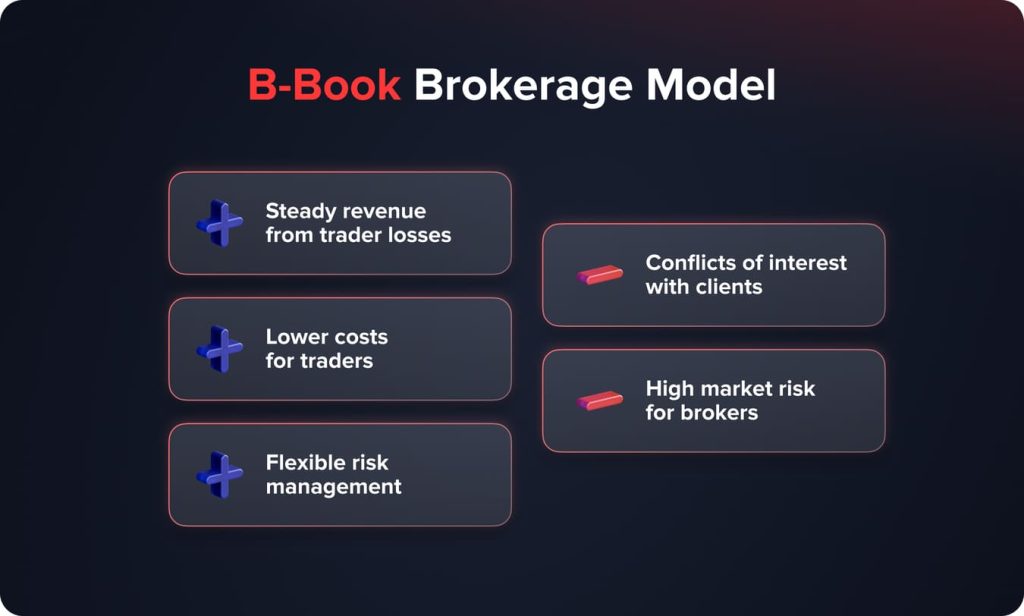
Các lợi ích của mô hình môi giới B-Book
Mô hình Giao dịch B-Book cho phép các nhà môi giới hoạt động như những người tạo lập thị trường, tạo ra một thị trường nội bộ riêng biệt cho khách hàng của họ. Cách tiếp cận này cung cấp cơ hội lợi nhuận đáng kể, vì các nhà môi giới có thể hưởng lợi từ những tổn thất của các nhà giao dịch, mang lại một dòng doanh thu ổn định không phụ thuộc vào điều kiện thị trường hay khối lượng giao dịch. Điều này có nghĩa là ngay cả trong những giai đoạn hoạt động thị trường thấp, các nhà môi giới vẫn có khả năng duy trì việc tạo ra doanh thu ổn định.
Một lợi ích khác là khả năng cung cấp chi phí giao dịch giảm, đặc biệt thu hút các nhà giao dịch có số dư tài khoản hạn chế. Bằng cách quản lý thị trường, các nhà môi giới có thể cung cấp chênh lệch giá và hoa hồng thấp hơn, làm cho việc giao dịch trở nên dễ tiếp cận và khả thi về tài chính cho một loạt các nhà giao dịch. Tính hiệu quả về chi phí này rất quan trọng đối với các nhà giao dịch nhằm tối đa hóa lợi nhuận trong khi giảm thiểu chi phí.
Hơn nữa, sự linh hoạt và kiểm soát vốn có trong mô hình B Book giúp các nhà môi giới quản lý hiệu quả mức độ rủi ro của họ. Họ có thể điều chỉnh chênh lệch và đòn bẩy được cung cấp cho các nhà giao dịch dựa trên đánh giá rủi ro, đảm bảo một môi trường giao dịch có quy định. Khả năng điều chỉnh các đề nghị kịp thời là rất quan trọng để duy trì sự ổn định của nhà môi giới và giảm thiểu tổn thất.
Nhược điểm của Mô hình Môi giới B-Book
Tuy nhiên, mô hình B Book đi kèm với xung đột lợi ích vì các nhà môi giới trực tiếp thu lợi từ những khoản thua lỗ của nhà giao dịch. Điều này có thể tạo ra cảm giác thiếu minh bạch và thiếu tin tưởng, có thể làm căng thẳng mối quan hệ giữa nhà môi giới và nhà giao dịch. Các nhà giao dịch có thể thận trọng trước sự thao túng của nhà môi giới và có thể nghi ngờ về tính công bằng và độ tin cậy của môi trường giao dịch được cung cấp.
Hơn nữa, các nhà môi giới phải đối mặt với rủi ro thị trường khi họ giữ các vị thế đối lập với các nhà giao dịch. Trong các thị trường biến động, các nhà môi giới có thể chịu thiệt hại lớn nếu nhiều nhà giao dịch có lợi nhuận. Điều này nhấn mạnh sự cần thiết của các chiến lược quản lý rủi ro và việc giám sát liên tục để điều hướng các biến động của thị trường và duy trì sự ổn định.
Mô Hình Môi Giới Hỗn Hợp
Mô hình môi giới Hybrid một cách tài tình kết hợp các đặc điểm của cả mô hình A-Book và B-Book, cung cấp cho các nhà môi giới một phương pháp hoạt động linh hoạt và thích ứng. Trong khuôn khổ tích hợp này, các nhà môi giới có quyền tự quyết định việc chuyển đơn đặt hàng của một nhà giao dịch trực tiếp đến các nhà cung cấp thanh khoản bên ngoài hoặc giữ lại trong nội bộ, do đó đóng vai trò là một bên đối tác.
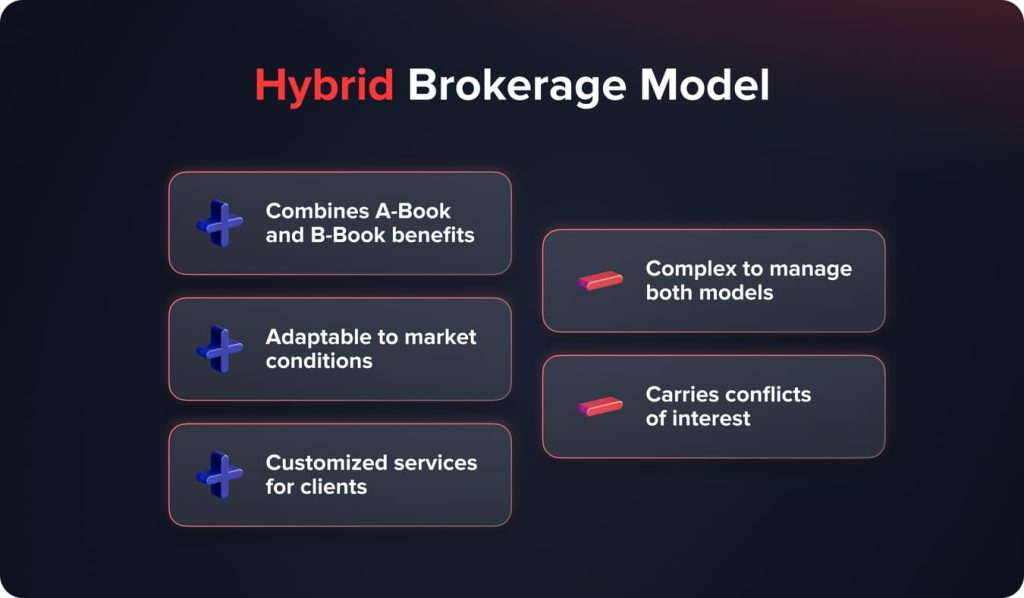
Các ưu điểm của Mô hình Môi giới Kết hợp
Mô hình môi giới lai kết hợp các yếu tố từ cả mô hình A Book và B Book để tận dụng các lợi ích của chúng. Sự kết hợp này cung cấp cho các nhà môi giới một cách tiếp cận để quản lý rủi ro và tạo ra doanh thu một cách hiệu quả. Bằng cách đánh giá điều kiện thị trường, hồ sơ giao dịch và mức độ rủi ro, các nhà môi giới có thể dễ dàng chuyển đổi giữa các hoạt động A Book và B Book để nâng cao lợi nhuận trong khi giảm thiểu rủi ro.
Độ linh hoạt của mô hình Hybrid cho phép các môi giới phục vụ các khách hàng đa dạng với sở thích giao dịch khác nhau, cung cấp dịch vụ tùy chỉnh giúp tăng sự hài lòng và trung thành của khách hàng. Bằng cách điều chỉnh các chiến lược của họ với nhu cầu của các nhà giao dịch và xu hướng thị trường, các môi giới có thể tạo ra một môi trường giao dịch hài hòa.
Nhược điểm của Mô hình Môi giới Lai
Quản lý cả hoạt động của Sách A và Sách B đồng thời gặp phải nhiều trở ngại. Nó đòi hỏi công nghệ, các chiến thuật quản lý rủi ro tinh vi và việc giám sát liên tục để tích hợp và thực hiện cả hai mô hình.
Mô hình Hybrid khá phức tạp và đòi hỏi sự lập kế hoạch, thực thi và giám sát. Thêm vào đó, nó mang theo những xung đột lợi ích từ mô hình B Book. Việc tìm kiếm sự cân bằng giữa tính minh bạch, công bằng và lợi nhuận là một thách thức cần xem xét và giao tiếp hiệu quả để duy trì niềm tin và sự hài lòng của nhà giao dịch. Các nhà môi giới phải điều hướng những tình huống khó xử này một cách cẩn thận để duy trì một nền tảng giao dịch công bằng.
Các xu hướng môi giới mới nổi vào năm 2025
Vào năm 2025, các mô hình môi giới sẽ phát triển để thích ứng với những tiến bộ công nghệ nhanh chóng, các quy định tăng cường, và kỳ vọng cao hơn từ khách hàng. Những nhà môi giới định vị mình để đáp ứng những thách thức này sẽ thu hút được một phạm vi khách hàng rộng hơn và vận hành các doanh nghiệp có lợi nhuận một cách bền vững.
Thực hiện dựa trên AI và Lập kế hoạch rủi ro thông minh
Tính đến năm 2025, AI và học máy sẽ không còn là tùy chọn - chúng sẽ trở thành điều cần thiết đối với cách mà các nhà môi giới hàng đầu kinh doanh. Các nhà môi giới hàng đầu sẽ sử dụng AI để:
- Thay đổi động giữa định tuyến A-Book và B-Book dựa trên hành vi và độ biến động của khách hàng trong thời gian thực.
- Tự động hóa việc phân tích rủi ro của khách hàng, cũng như việc cập nhật biên độ.
- Cải thiện độ chính xác của việc phòng ngừa nội bộ và giảm thiểu rủi ro với các giao dịch có rủi ro cao hơn.
Các mô hình được hỗ trợ bởi AI không chỉ tăng cường hiệu quả thực hiện mà còn cung cấp cho các nhà môi giới khả năng mở rộng để tiếp tục tăng cường hoạt động trong khi duy trì đúng các tiêu chuẩn tuân thủ và hiệu suất.
Phân khúc khách hàng & Mô hình thực hiện cá nhân
Các nhà giao dịch của năm 2025 sẽ được thông tin tốt hơn và đa dạng hơn bao giờ hết. Các nhà môi giới đã bắt đầu chuyển từ hình thức thực hiện chung sang các mô hình môi giới thích ứng, cá nhân hóa dựa trên:
- Mức độ kinh nghiệm (người mới bắt đầu so với chuyên nghiệp)
- Khả năng chấp nhận rủi ro
- Sở thích sản phẩm (FX, tiền điện tử, CFDs, v.v.)
Phong trào hướng tới việc thực hiện cá nhân đã dẫn đến các mô hình lai, sử dụng dữ liệu hành vi và lịch sử giao dịch để định tuyến các đơn hàng một cách thông minh, cũng như các mức giá, đòn bẩy và điều kiện giao dịch độc đáo.
Sự Minh Bạch và Kiểm Toán Được Quy Định
Quy định mới, cũng như sự phát triển liên tục của quy định, chẳng hạn như các thay đổi sau MiFID II ở EU, chế độ giám sát kỹ thuật số mới đang chờ xử lý của SEC cho các nhà môi giới ở Mỹ, và cải cách tiền của khách hàng mới của ASIC ở Úc, đang làm tăng cường giám sát việc thực hiện giao dịch, phân tách quỹ và thực tiễn báo cáo. Đến năm 2025, các nhà môi giới sẽ phải:
- Cung cấp hồ sơ giao dịch có thể kiểm toán đầy đủ,
- Đảm bảo tiết lộ đầy đủ về thời điểm và lý do thực hiện A-Book hoặc B-Book,
- Cung cấp sự minh bạch hơn về các mô hình định giá và phụ phí.
Các nhà môi giới lai được quản lý đang đầu tư vào cơ sở hạ tầng tuân thủ để đảm bảo rằng họ không bị trừng phạt vì không tuân thủ, đồng thời cũng bảo vệ những gì còn lại của lòng tin từ khách hàng.
Quy định và Các yếu tố đạo đức
Trong thế giới môi giới, các quy định nghiêm ngặt và hướng dẫn đạo đức đóng một vai trò rất lớn. Những điều này được thiết lập bởi các cơ quan quản lý toàn cầu như Cơ quan Quản lý Tài chính (FCA), Ủy ban Giao dịch Hàng hóa Tương lai (CFTC) và Ủy ban Chứng khoán và Đầu tư Úc (ASIC), nhằm đảm bảo sự an toàn và công bằng trong các thực hành giao dịch. Những tổ chức này xây dựng và thi hành các quy tắc mà các nhà môi giới phải tuân thủ, đảm bảo tính minh bạch và công bằng, cũng như bảo vệ lợi ích của các nhà giao dịch.
Các quy định bao gồm các khía cạnh của môi giới như:
- Minh bạch,
- Tận dụng,
- Các yêu cầu về biên,
- Bảo vệ khách hàng.
Điều này rất cần thiết để duy trì một môi trường giao dịch đạo đức và chúng phát triển cùng với những thay đổi trên thị trường để giải quyết các rủi ro và thách thức trong hoạt động môi giới, nhấn mạnh tầm quan trọng của việc các nhà môi giới cần phải luôn cập nhật thông tin và tuân thủ.
Cân nhắc Đạo đức trong Các Mô hình Môi giới
Các mô hình môi giới đi kèm với những đặc điểm hoạt động độc đáo của chúng, mang lại những tình huống đạo đức cụ thể, đặc biệt liên quan đến xung đột lợi ích và duy trì niềm tin trong mối quan hệ giữa môi giới và nhà giao dịch.
- Mô Hình A-Sách
Trong các mô hình A-Book, các nhà môi giới hoạt động như những trung gian trung lập chỉ thực hiện giao dịch của khách hàng và chuyển nó cho một nhà cung cấp thanh khoản bên ngoài. Khi nhà môi giới đóng vai trò là trung gian trong giao dịch, lợi ích mâu thuẫn giữa nhà môi giới và nhà giao dịch tự nhiên sẽ đồng nhất và tạo ra sự công bằng, đồng thời giảm thiểu rủi ro của một cuộc xung đột có thể xảy ra.
- Mô Hình B-Sách
Trong mô hình B-Book, các nhà môi giới là bên đối tác của các giao dịch khách hàng, và do đó kiếm tiền từ những khoản lỗ của khách hàng. Do đó, các nhà môi giới B-Book nên hành động một cách thận trọng và công bằng để tránh rơi vào cái bẫy xung đột lợi ích vốn có này. Một nhà môi giới B-Book có đạo đức phải công khai đầy đủ mô hình của họ và tránh tham gia vào các thực hành phi đạo đức như làm mờ giá cả hoặc săn lùng lệnh dừng.
- Mô hình lai
Các nhà môi giới lai tự nhiên có một mô hình đạo đức phức tạp hơn vì họ sử dụng các khía cạnh của mô hình A-Book và cũng vận hành B-Book. Các nhà môi giới sử dụng các mô hình lai phải cẩn thận về cách và lý do mà các đơn hàng của khách hàng được chuyển hướng nội bộ hoặc bên ngoài, nhưng họ cũng phải có khả năng đối xử với các phân khúc trong cơ sở khách hàng của họ một cách nhất quán và công bằng. Các nhà môi giới lai cần phải minh bạch và đồng thời có sự linh hoạt trong các quy trình hoạt động, và họ nên giải quyết các vấn đề liên quan đến công bằng và quy trình hoạt động để tăng cường sự rõ ràng thông qua việc giao tiếp thích hợp, lập hồ sơ rủi ro và kiểm soát vững chắc.
Tầm quan trọng của Đạo đức và Tuân thủ
Hành xử đạo đức là một nghĩa vụ, nhưng nó cũng là một lợi thế chiến lược trong thế giới cạnh tranh của môi giới vào năm 2025. Các môi giới thể hiện việc thực hiện giao dịch một cách minh bạch, đối xử với khách hàng một cách đạo đức, và cũng tuân thủ đầy đủ các yêu cầu quy định, có thể:
- Xây dựng niềm tin và sự trung thành lâu dài giữa các khách hàng,
- Ngăn chặn sự phơi bày danh tiếng và các hình phạt quy định,
- Liệt kê các khách hàng chất lượng cao trong lĩnh vực giao dịch tổ chức và chuyên nghiệp.
Suy Nghĩ Cuối Cùng
Hiểu biết về các mô hình môi giới, cách chúng hoạt động và các cân nhắc đạo đức liên quan là điều cần thiết, cả đối với các nhà giao dịch và các môi giới. Việc chọn một mô hình môi giới phù hợp với mục tiêu giao dịch, khả năng chấp nhận rủi ro và các nguyên tắc đạo đức của các mô hình là rất quan trọng để đảm bảo trải nghiệm giao dịch dựa trên sự minh bạch, tin cậy và tôn trọng lẫn nhau. Các môi giới cần phải điều chỉnh chiến thuật của họ với các yêu cầu và tiêu chuẩn đạo đức để tạo ra một môi trường giao dịch công bằng và minh bạch, hỗ trợ sự bền vững và hợp pháp của doanh nghiệp họ. Khi các tiêu chuẩn đạo đức, hướng dẫn quy định và sở thích cá nhân hòa hợp với nhau, điều đó tạo ra một môi trường giao dịch công bằng và cân bằng, mang lại lợi ích cho cả các nhà giao dịch và các môi giới trong các thị trường ngày nay.
FAQ
Làm thế nào để các nhà môi giới xác định mô hình sử dụng?
Các nhà môi giới chọn mô hình thực hiện của họ - A-Book, B-Book, hoặc Hybrid - dựa trên sự kết hợp của nhiều yếu tố, bao gồm:
- Hồ sơ và hành vi của cơ sở khách hàng của họ (chuyên nghiệp so với bán lẻ),
- Các quy định, nếu có, chi phối họ, và nơi họ đang kinh doanh,
- Các khả năng kỹ thuật của họ liên quan đến việc định tuyến thông minh và quản lý rủi ro,
- Khả năng chấp nhận rủi ro và mục tiêu lợi nhuận của chính họ.
Nhiều nhà môi giới hiện đại ngày nay có các phương pháp linh hoạt hoặc hỗn hợp, để họ có thể phục vụ tốt hơn các nhu cầu đa dạng của các nhà giao dịch trong khi quản lý rủi ro kinh doanh của chính mình.
Có thể tôi, với tư cách là một nhà giao dịch, chọn giữa một nhà môi giới A-Book hoặc B-Book không?
Có, các nhà giao dịch có thể chọn nhà môi giới của họ theo mô hình thực hiện mà họ ưa thích. Các nhà môi giới thường chuyên biệt hoàn toàn trong A-Book hoặc B-Book hoặc hoạt động theo các mô hình Hybrid. Do đó, điều quan trọng là các nhà giao dịch phải thực hiện thẩm định về chính sách thực hiện của một nhà môi giới và cách nó liên quan đến chiến lược giao dịch, mức độ chấp nhận rủi ro và mức độ minh bạch của họ.
Mô hình Hybrid có vượt trội hơn mô hình A-Book hay mô hình B-Book không?
Các mô hình lai là độc đáo vì chúng là sự kết hợp giữa thực hiện A-Book và thực hiện B-Book. Phương pháp này cung cấp cho nhà môi giới sự linh hoạt hoàn toàn để điều chỉnh quản lý rủi ro và lợi nhuận liên quan đến thị trường hiện tại và hồ sơ của khách hàng. Mô hình thực hiện phải minh bạch, và do đó, quyết định định tuyến cũng phải minh bạch và được thông báo cho khách hàng. Một mô hình lai có thể hấp dẫn đối với khách hàng, nhưng hãy xem xét rằng đối với một số nhà giao dịch, việc sử dụng nhà môi giới A-Book thuần túy có thể mang lại sự đảm bảo hơn rằng việc thực hiện thực sự là không thiên vị.
Đã cập nhật:
9 tháng 10, 2025




